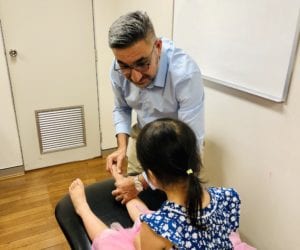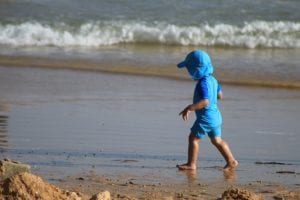Kids must kick off shoes for summer!
- Dr Abbie Clinics
- December 17, 2018
- News

Podiatrist, Dr Abbie Najjarine assesses a child at his Kirrawee Clinic
Summer is here and it is the perfect time for growing feet to get exposed to the elements for strength and development, whilst parents get the chance to check their child’s lower limb and foot development.
According to Podiatrist and biomechanics expert, Dr Abbie Najjarine of Dr. Abbie Clinics in Sydney and NSW, who has treated thousands of children over his 30 year career, natural ground stimulates proprioception – how we perceive the position and movement of our body – which allows muscles to be activated and work effectively.
“In summer kids must get their bare feet into the sand and onto the grass, because unlike hard, manmade surfaces, natural ones mold to the feet and put less strain on lower limbs, not the other way round, so kids should take advantage,” he said.
“Whilst a child is running around playing and moving in nature, it’s also the best opportunity for parents to look at how they are moving: are they running straight or are they tripping over? Are they upright or are they off kilter?” said Dr Najjarine.

When a child walks in sand it stimulates muscles
Sand in particular helps muscle stimulation and plenty of play helps build foot and limb strength said Dr Najjarine. But he warns parents to watch for the signs.
“If their child is clumsy and often trips up, complains of pain in the legs and feet at night or being tired after walking or playing, it’s a sign something may not be right, so it’s best to get a professional assessment while your child is growing and developing,” Dr Najjarine said.
“Often parents will say that children having pain in the legs are growing pains, but these are actually not normal, if it was, every child would suffer from the same pain, which is not the case,” he said.
According to Dr Najjarine for many years it people thought that children with ‘pigeon toes,’ ‘out toeing’ or ‘flat feet’ issues would correct themselves, as it does appear to improve with age. However, by the time a child reaches the age of six, this position will not correct any further unless it is encouraged to do so through specialised treatment.
Diseases like Severs disease occur in children when growth plates have not yet become ossified. The combination of growth, bad biomechanical structure and function combine to cause inflammation and pain at the point where the Achilles tendon attaches to the heel bone. Excessive pronation can be a major contributing factor together with the child’s growth spurt pattern.
“So like a growing tree, if you don’t support it as it gets taller and it’s leaning, the lean will get worse and the foundations will be get weaker. Trying to fix faults later are much harder, so better to nip them in the bud,” said Dr Najjarine.
“When children are growing, their bones are soft and malleable and treatments such as exercise or orthotic therapy – which are special insole or shoes – are excellent regimes. Orthotic in particular will re-align the biomechanical structure and control certain issues in the feet, stabilising the lower limb structure.
“So my advice to all parents at this time is to not be afraid, get their kids shoes off and let them play as much as possible in their bare feet. Don’t wrap them in cotton wool, let them enjoy the natural surfaces, get strong and get to know their growing feet, you may also spot a problem and get it fixed early,” concluded Dr Najjarine.
If you are concerned about your child’s walking gait, foot strength or any other issues contact 1800 DR ABBIE or email reception@dr.abbie.com


